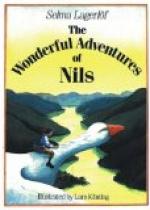The handsome old gentleman had raised his voice, so that it rang out strong and commanding, and his eyes shone. Then he rose, and, with a wave of his hand to Clement, walked away. Clement understood that the one who had been talking to him was a great man, and he bowed to him as low as he could.
The next day came a royal lackey with a big red book and a letter for Clement, and in the letter it said that the book was from the King.
After that the little old man, Clement Larsson, was lightheaded for several days, and it was impossible to get a sensible word out of him. When a week had gone by, he went to the superintendent and gave in his notice. He simply had to go home.
“Why must you go home? Can’t you learn to be content here?” asked the doctor.
“Oh, I’m contented here,” said Clement. “That matter troubles me no longer, but I must go home all the same.”
Clement was quite perturbed because the King had said that he should learn all about Stockholm and be happy there. But he could not rest until he had told every one at home that the King had said those words to him. He could not renounce the idea of standing on the church knoll at home and telling high and low that the King had been so kind to him, that he had sat beside him on the bench, and had sent him a book, and had taken the time to talk to him—a poor fiddler—for a whole hour, in order to cure him of his homesickness. It was good to relate this to the Laplanders and Dalecarlian peasant girls at Skansen, but what was that compared to being able to tell of it at home?
Even if Clement were to end in the poorhouse, it wouldn’t be so hard after this. He was a totally different man from what he had been, and he would be respected and honoured in a very different way.
This new yearning took possession of Clement. He simply had to go up to the doctor and say that he must go home.
GORGO, THE EAGLE
IN THE MOUNTAIN GLEN
Far up among the mountains of Lapland there was an old eagle’s nest on a ledge which projected from a high cliff. The nest was made of dry twigs of pine and spruce, interlaced one with another until they formed a perfect network. Year by year the nest had been repaired and strengthened. It was about two metres wide, and nearly as high as a Laplander’s hut.
The cliff on which the eagle’s nest was situated towered above a big glen, which was inhabited in summer by a flock of wild geese, as it was an excellent refuge for them. It was so secluded between cliffs that not many knew of it, even among the Laplanders themselves.
In the heart of this glen there was a small, round lake in which was an abundance of food for the tiny goslings, and on the tufted lake shores which were covered with osier bushes and dwarfed birches the geese found fine nesting places.
In all ages eagles had lived on the mountain, and geese in the glen. Every year the former carried off a few of the latter, but they were very careful not to take so many that the wild geese would be afraid to remain in the glen. The geese, in their turn, found the eagles quite useful. They were robbers, to be sure, but they kept other robbers away.




